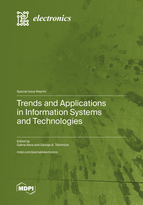Trends and Applications in Information Systems and Technologies
A special issue of Electronics (ISSN 2079-9292). This special issue belongs to the section "Computer Science & Engineering".
Deadline for manuscript submissions: closed (10 June 2023) | Viewed by 30717
Special Issue Editors
Interests: information systems and technologies; business intelligence; big data; intelligent software agents; machine learning; data mining; multi-criteria decision making; fuzzy sets
Special Issues, Collections and Topics in MDPI journals
Interests: computational intelligence; pattern recognition; artificial intelligence
Special Issues, Collections and Topics in MDPI journals
Special Issue Information
Dear Colleagues,
In the current competitive and dynamic environment, information technologies change business models and significantly affect companies’ performance. By digitally transforming its value chain, a company can predict evolving customer preferences, optimize work processes and achieve operational excellence. The rapid penetration of information technologies has set into focus big data and business intelligence, bringing new opportunities for innovation and increased efficiency. Digital connectivity and distributed computing have further accelerated the proliferation of information systems. However, these systems pose new technological challenges, such as cybersecurity, big data analytics and data-driven decision making.
Contrary to expectations, the implementation of information systems does not necessarily lead to desired performance. Information systems are complex structures comprising hardware, software, data and users, who consume computational services. IT assets can lead to unsatisfactory results if a system is poorly designed or does not meet user needs.
This Special Issue focuses on the main challenges in building and employing information systems: 1) developing innovative architecture, including computers, networks and software, to coordinate supply chains and help organizations become independent from their location; 2) analyzing large volumes of IoT, transactional and social data to support precise planning, forecasting and monitoring of the business; and 3) identifying key applications of information systems and analytical platforms in practice. Computer science researchers are invited to contribute their original, unpublished works on this issue. Both research and review papers are welcome.
Prof. Dr. Galina Ilieva
Prof. Dr. George A. Tsihrintzis
Guest Editors
Manuscript Submission Information
Manuscripts should be submitted online at www.mdpi.com by registering and logging in to this website. Once you are registered, click here to go to the submission form. Manuscripts can be submitted until the deadline. All submissions that pass pre-check are peer-reviewed. Accepted papers will be published continuously in the journal (as soon as accepted) and will be listed together on the special issue website. Research articles, review articles as well as short communications are invited. For planned papers, a title and short abstract (about 100 words) can be sent to the Editorial Office for announcement on this website.
Submitted manuscripts should not have been published previously, nor be under consideration for publication elsewhere (except conference proceedings papers). All manuscripts are thoroughly refereed through a single-blind peer-review process. A guide for authors and other relevant information for submission of manuscripts is available on the Instructions for Authors page. Electronics is an international peer-reviewed open access semimonthly journal published by MDPI.
Please visit the Instructions for Authors page before submitting a manuscript. The Article Processing Charge (APC) for publication in this open access journal is 2400 CHF (Swiss Francs). Submitted papers should be well formatted and use good English. Authors may use MDPI's English editing service prior to publication or during author revisions.
Keywords
- information technologies
- cloud computing
- IoT
- big data
- blockchain
- data analytics
- vendor management







